
Many sellers who already sell on eBay and Amazon are looking to expand their eCommerce business and rightfully so. There are a number of marketplaces you can actually make money on today, which sellers are unaware of, let’s cross Walmart off that list together! Selling on Amazon for many presents an opportunity ripe for the taking, especially if you already have an established customer base on other marketplaces.
Why not tap into a new revenue stream ?
I’m guessing though that I do not have to convince you since whoever is reading this article understands the value of expanding their eCom business to the ‘blue side’ (see Walmart’s logo). It is actually my pleasure to introduce you to a new marketplace, I consider it my passion, just the other week I introduced Etsy with a beginner’s guide and this week I will be:
- Tell Walmart’s success story through numbers.
- Compare Walmart with eBay and Amazon.
- Help you understand if Walmart is the right choice for you as a seller (including the pros and cons of this marketplace).
- Walk you through all of Walmart’s seller fees.
- Give you 5 exclusive Walmart seller tips for beginners.
Walmart Online Marketplace - A Success Story
Let’s talk a bit about the Walmart miracle! We all know Walmart stores – they are like the modern American church.
- You have a Walmart in your neighborhood.
- A Walmart at the mall.
- A Walmart when you are on vacation in Miami, Vale.
- And when you are visiting your best friend from college in San Francisco.
They are literally everywhere. But in recent years, Walmart has been able to recreate that success online. According to Similar Web, Walmart currently has upwards of 330 million unique monthly visitors:
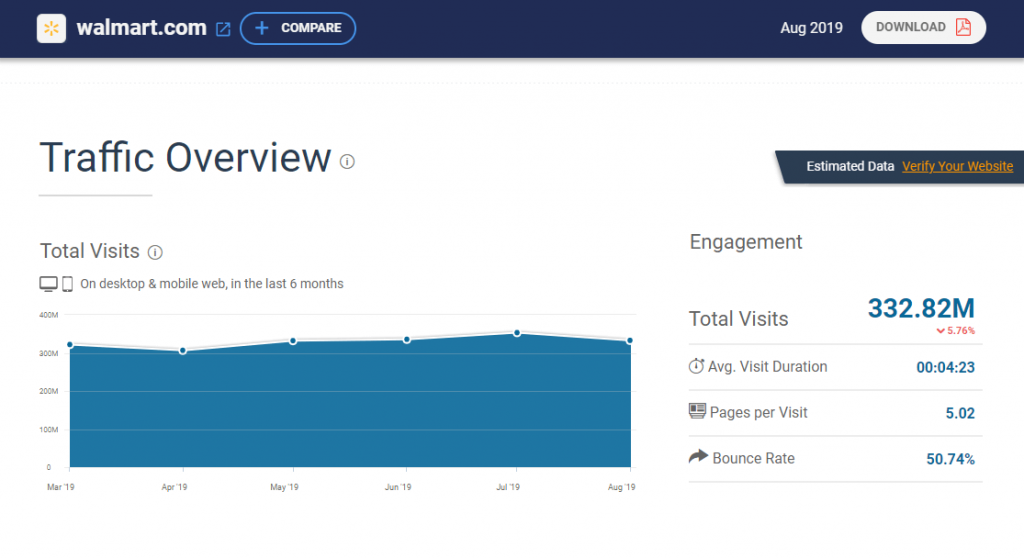
That is a nice customer base which you can definitely start tapping into today.
Additionally, according to Statista, Walmart saw a 63% growth in eCommerce sales in Q1 of 2018 and ‘only’ a 43% growth in eCommerce sales in Q1 of 2019 but don’t let this dip fool you – 43% growth by any standards is insanely good!
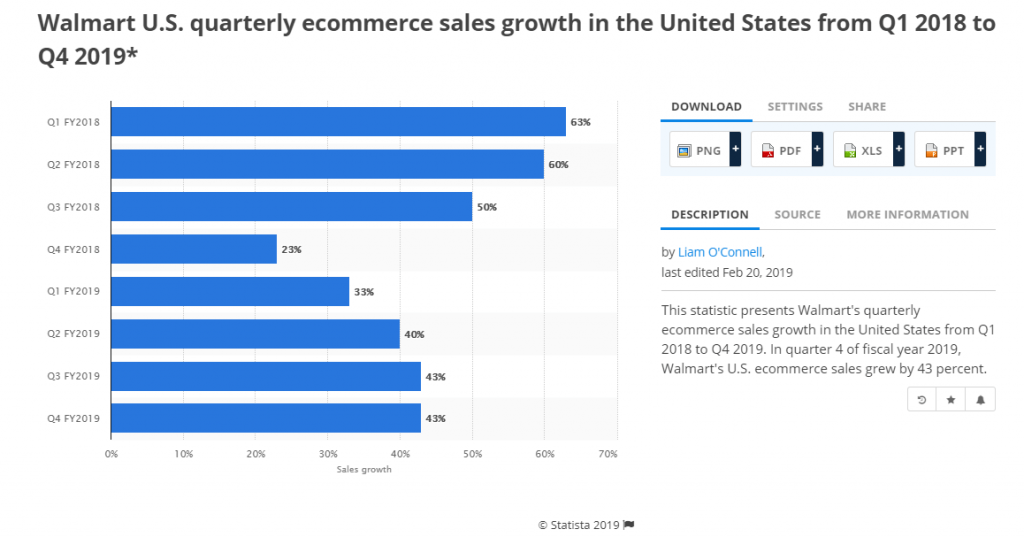
When you compare Amazon, eBay and Walmart as in terms of total eCommerce sales in 2019:
- Amazon is the clear leader with 47% of total eCommerce sales in the US.
- eBay is way behind in second with 6.1% of total eCommerce sales in the US.
- Yet Walmart is right there behind eBay 4.6% of market share.
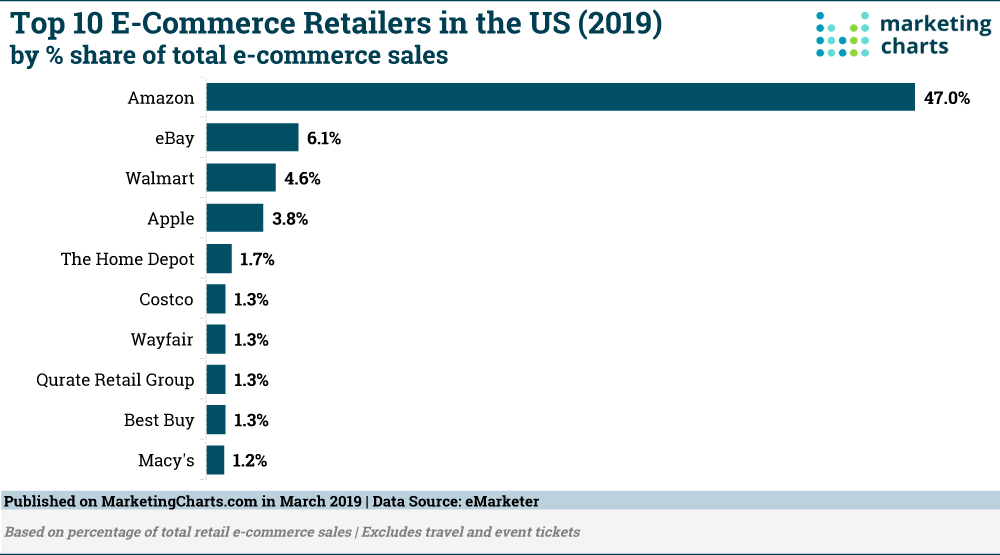
Source: Marketing Charts
And I have to say that there is something to be said for not competing on America’s biggest or even second-biggest online marketplace. It is very similar to one of my colleague’s experiences as a writer, in the US he was one among many but when he moved abroad as an English speaking writer, the ‘scarcity’ aspect kicked in and demand was much higher for his particular skill set. That same logic and set of ‘rules’ can be applied in the Walmart marketplace, you are a smaller fish in a smaller pond which means that you have a greater chance of ‘eating’ or capturing a nice piece of market share.
Walmart Vs. Amazon
We already saw above how Walmart is a spec of dust in Amazon’s rearview mirror – Amazon has nearly 50% of the American eCommerce market in its clutches whereas Walmart has close to 5% Of market share, making it one-tenth the size. Beyond numbers – let’s compare the selling experience on both marketplaces:
- Responsibility: With Amazon, you can send your product into Amazon FBA and not have to think about shipping, returns, item exchanges and customer service but with Walmart, you need to handle all these aspects independently.
- Entry threshold: Becoming a seller on Amazon is pretty straightforward and open to the general public (if you remain a seller is based on your ability to comply with Amazon policies and overall performance as a seller). This is not the case with Walmart, views themselves like the exclusive fraternity which you can only get into by invitation or applying and meeting certain predetermined criteria.
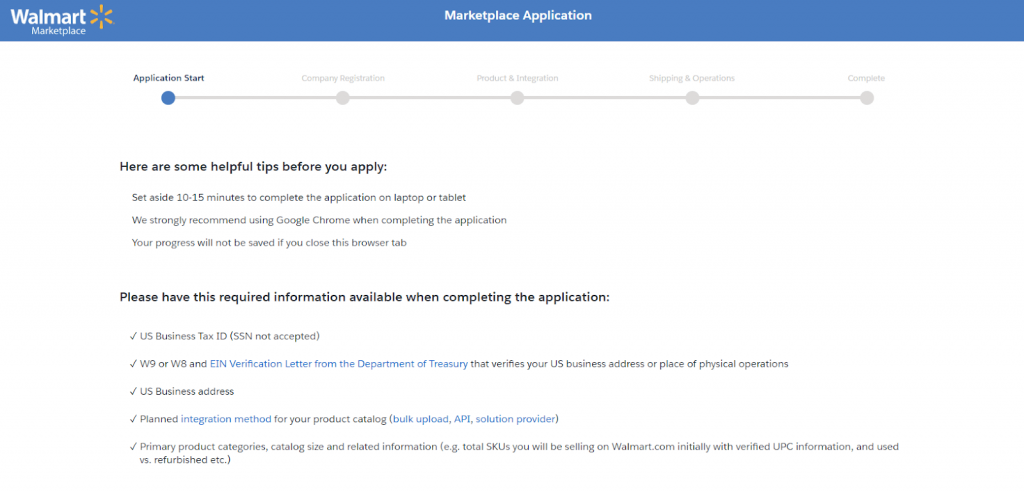
The good news is that you will only be competing with high quality, trustworthy sellers, the downside is that you have to pass Walmart’s strict screening process. Walmart is looking for sellers who:
- Offer great prices.
- Have a nice product selection.
- Provide top-notch customer support.
- Ensure the fulfillment is swift and reliable.
You will also be asked to provide some personal information about your business such as:
- What percentage of your ratings are positive on eBay and/or Amazon.
- The number of reviews received over the previous 12-month period.
- Details of your eBay and/or Amazon account.
- The average order value processed by your other eCom businesses.
Shipping: Walmart has decided to challenge Amazon head-on as far as shipping goes. Walmart decided to make a bold move by introducing free 2-day shipping to all buyers who spend upwards of $35 on their marketplace. And the real kicker is that you don’t need to pay for or sign up for a membership.

Amazon, on the other hand, offers Amazon Prime as its premier shipping service. Prime gives buyers access to Kindle books, video streaming as well as ‘free’ 2-day, one-day and same-day shipping options but comes at a subscription fee of – $119 annually or $12.99 per month.

Walmart Vs. eBay
For those of you wondering what the main differences between Walmart’s marketplace and eBay, here is some food for thought:
- Listing ownership – eBay gives sellers control of their own product listings. The seller decides what to write, which images to feature etc.. This is great since it allows sellers to tailor their listings to their brand’s values and draw attention to their specific product’s advantages. On Walmart however, similar to Amazon, all identical items are listed under one common listing which gives sellers close to no control over how their product is presented to the general public and decreases their ability to stand out against their competition (save for on price and reviews).
- Entry threshold – Similar to what I said above regarding Amazon, eBay is open to the general public. It is up to you to prove your worth in the free market. If you do a good job, you succeed and if not, you fail (that is quite an oversimplification, I know). In terms of Walmart, you need to be the cream of the crop as far as eCommerce sellers go in order to be ‘accepted to the club’.
- Competition – Following up on the previous point, since Walmart’s screening process is so thorough, the sellers who you compete against tend to be of a certain caliber. Many of the shady practices such as underselling, fake accounts, fake reviews etc are much less prevalent on Wlamart’s marketplace than on eBay.
Who is Walmart for?
In this section, I will walk you through the advantages and disadvantages of selling on Walmart. As you will soon see, selling on Walmart is geared towards:
- Seasoned sellers with eCommerce experience and a proven track record on other eCommerce marketplaces and/or their own retail site.
- Larger eCommerce operations who can handle all the intricacies of shipping, fulfillment, customer support and returns independently.
- eCommerce businesses whose strategy is largely based on high volume sales coupled with narrow profit margins.
Pros of Selling on The Walmart Marketplace
Selling on Walmart has some serious advantages when compared with other marketplaces. Here are the top reasons why I would recommend you start selling on today:
- Zero Setup fees + Zero monthly fees – On Walmart marketplace, sellers pay a ‘referral fee’ which Walmart charges based on a given item’s category, you will not, however, pay a monthly fee as you do with Amazon Pro for example which costs $39.95 (as an individual seller you pay $1 per listing so it pays to be an individual up to 40 items per month, beyond that a ‘pro’ account makes more sense as the $1 is ‘waived’). But with Walmart, you will not have this headache. Also, there are no hidden setup fees with Walmart.
- Success by association – Though this has not been corroborated by ‘science’, many sellers claim to experience a significant boost in sales on their own eCommerce retail platforms since they started selling on Walmart. Many attribute this to an increase in brand awareness meaning once a buyer has seen your brand on Walmart they attribute your brand a higher status and quality. Later on, they may remember your brand and search for it independently and complete the purchase process on your site and not Walmart’s.
- Increased consumer exposure – Yes, there are many buyers who are Amazon fanatics and ‘Prime junkies’ but there are many customers who aren’t using Amazon exclusively as well as people who don’t shop on Amazon at all ( ie 53% of the American population). And even if they do shop on Amazon, research shows that online shoppers tend to browse on more than one site when looking to buy an item – more specifically two-thirds of all shoppers. If you have a presence on those sites then you are more likely to make a sale. So you are killing two birds with one stone – increased exposure to new customers and ‘reassuring’ customers from other marketplaces that you are ‘ever-present’.
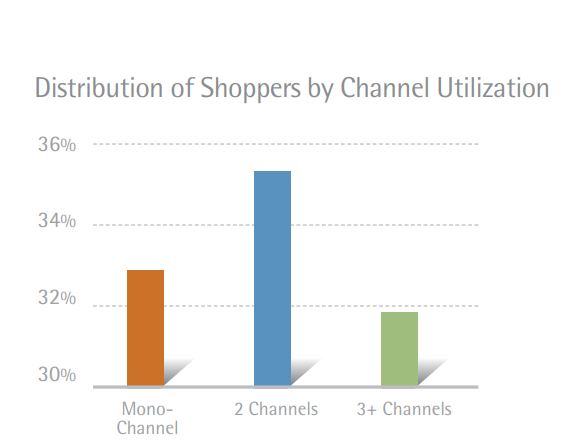
Source: VerdeGroup
4. Sales volume is higher – Since one of Walmart’s prerequisites for becoming a seller on their marketplace is offering ‘competitive pricing’, many sellers have noticed that their per-item margins are lower than on other marketplaces which on the surface sounds like it is a disadvantage. And it can be to some extent, but the positive side of this equation relates to the fact that sales volumes are significantly higher on the Walmart marketplace meaning you will sell more product at a lower profit per item but when approached correctly you can still end up on top in terms of revenue stream.
5. Improved seller support – To put it nicely, Amazon seller support is awful. Many a seller has been extremely frustrated trying to get their hands on an Amazon rep to solve their issues in real-time. In contrast, Walmart has actually made serious improvements to its seller support by opening up a seller hotline as well as a menu that is interactive and can help sellers solve problems in real-time.
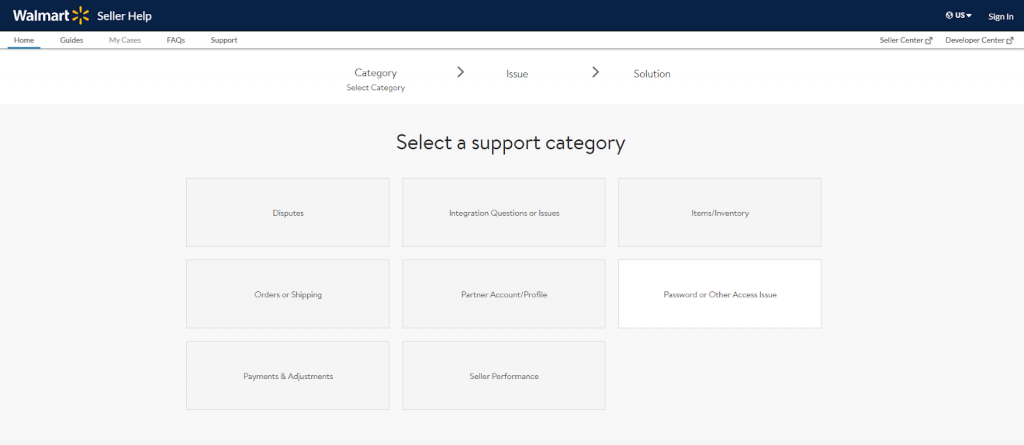
Cons of Selling on The Walmart Marketplace
Nothing is ever all sunshine, and Walmart is no exception. Here are some of the less pleasant aspects of selling with the Walmart marketplace:
- Shipping policies – Walmart offers sellers 5 methods of shipment to choose from. The big caveat though is clearly the fact that they completely forbid ‘branded packaging’ as well as any materials from companies other than Walmart. This clearly limits sellers who are looking to build their own brand in tandem with their eCommerce marketplace stores. Also, be careful to not use Amazon FBA for Walmart order storage and fulfillment as this is also strictly prohibited according to Walmart’s policies. This makes Walmart a clear choice for larger retailers who have their own warehouse and fulfillment centers and may prove hard for smaller sellers to keep up.
- Listing challenges – Many sellers have experienced issues with Walmart’s item catalog which is run on a first list basis. This means, whichever seller puts an item up first get to occupy said item’s listing and all additional sellers with the same product are added on to that listing. This can be frustrating especially when it comes to listing a product based on a specific UPC or Universal Product Code, only to find out that that specific UPC is already being used by another seller. Check out what one Walmart seller had to say about this issue on Reddit:

3. Low revenue margins – I mentioned this earlier and it can be both an advantage or disadvantage depending on where you are coming from. If your business model is built on high sales volume and small margins then you are in luck. But what if you rely on a model that is based on low sales volume and high margins? Or what if you can’t reach the volume necessary for your Walmart store to be profitable? These automatically render Walmart as a non-viable option for you and your business and can be one of the biggest discouraging factors for a given business.
4. Bad seller support – Customer support isn’t as good as it is supposedly cracked up to be. I know above I said that seller support is better than Amazon but there are always two sides to the same coin and some sellers would beg to differ with me. Check out this Reddit review of Walmart seller support:
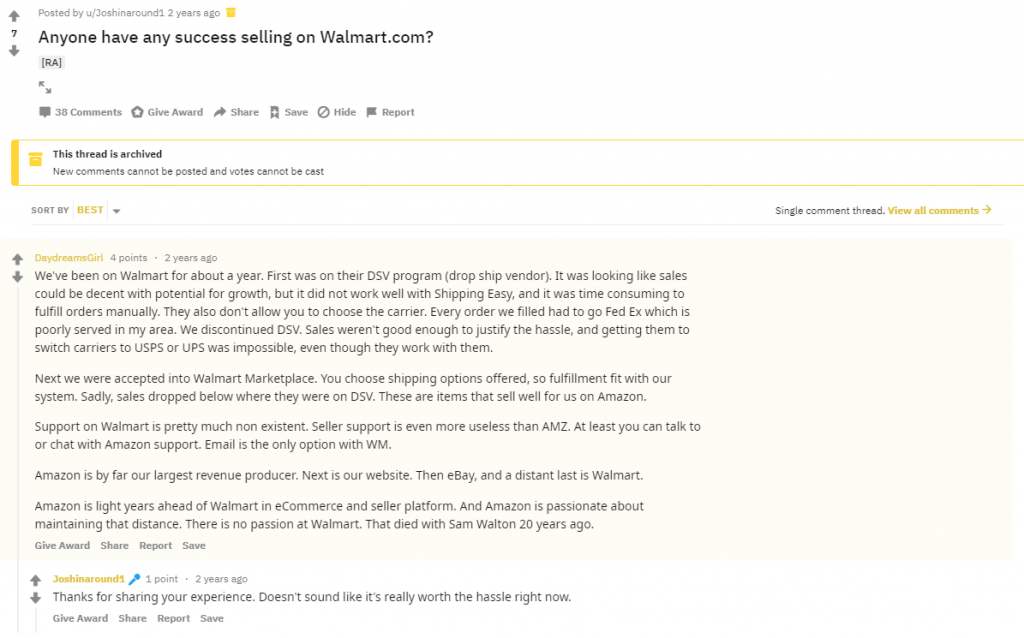
5. Strict pricing prerequisites – Walmart.com allows sellers to choose their own pricing schemes but as you remember ‘competitive pricing’ is one of the prerequisites for new Walmart seller acceptance which is what leads to low-profit margins. This means that Walmart feels that they have a vested interest in keeping product prices low in the interest of keeping consumers coming back for their next shopping fix. Some sellers have found their products delisted for price competition, which is disconcerting to say the least.
Walmart Seller Fees Explained
Walmart marketplace fees are surprisingly very simple and straightforward. The only fee sellers need to pay are called ‘Referral Fees’ which is a percentage of the item’s sale price based on said item’s category – percentages range from 6% for ‘Personal Computers’ to 15% for categories like ‘Watches’, ‘tools & Home Improvement’, and ‘Sporting Goods’. Here is the full list of Referral Fees as listed on Walmart’s website:
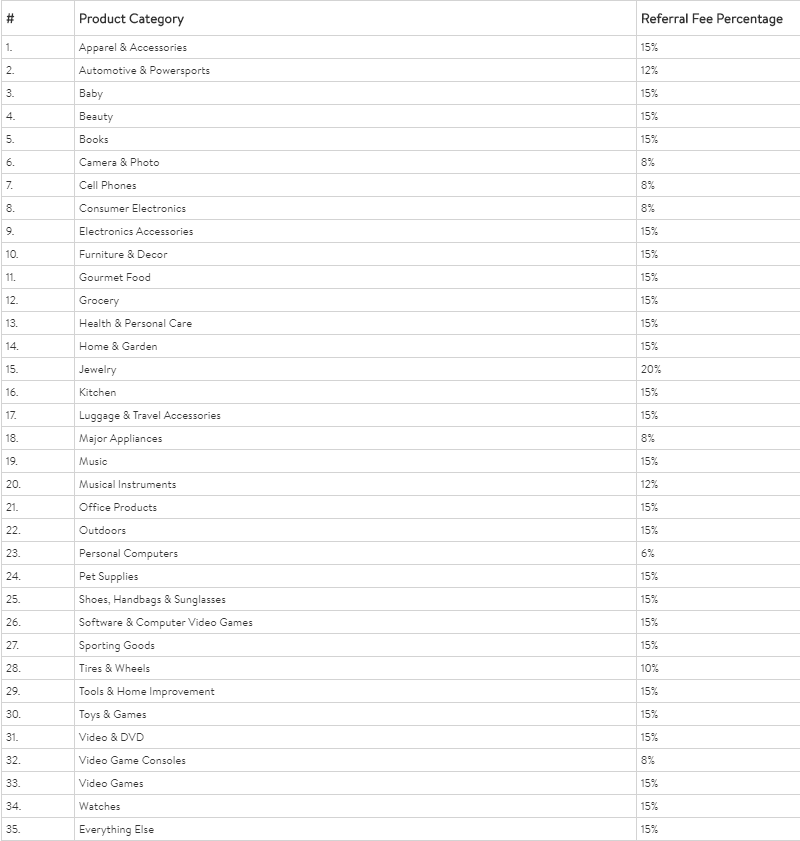
Getting Paid by Walmart
Here are the most important things you should know about getting paid on Walmart’s marketplace:
- Sellers are typically paid on a weekly basis.
- Walmart automatically deducts their referral fees from transactions.
- Sales periods on Walmart are defined as Monday-Monday, midnight to midnight and funds are transferred by 12:00 o’clock the following Wednesday.
- Sales are only logged by Walmart on the day of shipment and not on the day when the order was placed.
All these factors are important, especially when trying to properly plan your Walmart store’s cash flow on a weekly, monthly or even yearly basis.
The Ultimate 5 Tips For Walmart Rookies
If after reading this post, you have decided that Walmart is the way to go in terms of expanding your business then I would like to give you 5 tips to help get you started on the right foot:
- Use advertising – Walmart offers sellers a variety of ways in which they can promote their listings on the Walmart marketplace. These include:
- Ads which are sponsored
- Organic-based search
- Ads which are ‘native’
- Banner ads

These advertising methods will help get your listings in front of high intent buyers who are actively surfing the Walmart marketplace to either make a purchase now or later. When you do decide to run an advertising campaign be sure to:
- Include links in your advertisements to individual product pages.
- Try different types of ads – play around with the pictures and ad copy (ie the written text) and see which version converts best.
- Try promoting different items at strategic times. A shaving kit close to fathers day, heart-shaped chocolates close to Valentine’s Day etc…
2. Ensure customers leave reviews – Social proof is paramount in the world of eCommerce. 90% of buyers admit to making a purchase decision based on the recommendation of a friend, acquaintance or even a total stranger who has left a review.
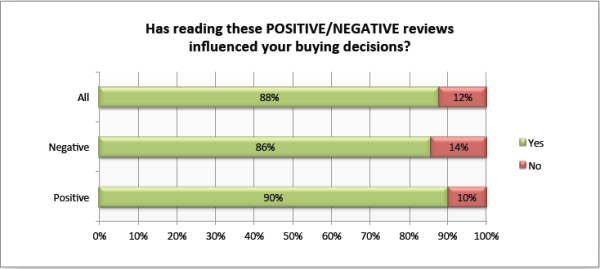
Source: Marketing Land
As I mentioned earlier, Walmart has strict criteria when accepting new third-party sellers so if you have been accepted due to your excellence, do your utmost to maintain this high level of service, this includes but is not limited to :
- Making sure all shipments go out on time.
- Doing your best to never cancel orders and ensuring you always have actively listed items in stock.
Additionally, be sure to follow up with buyers and make sure they are happy with the item and that they know how to set it up. If you become aware of a problem and resolve it before the client even has the time to leave you a review then you are taking a pre-emptive approach to your Walmart store and will be putting yourself on track to having 100% positive feedback which is key to generating current and future business.
3. Qualify for the ‘Buy Box’ –
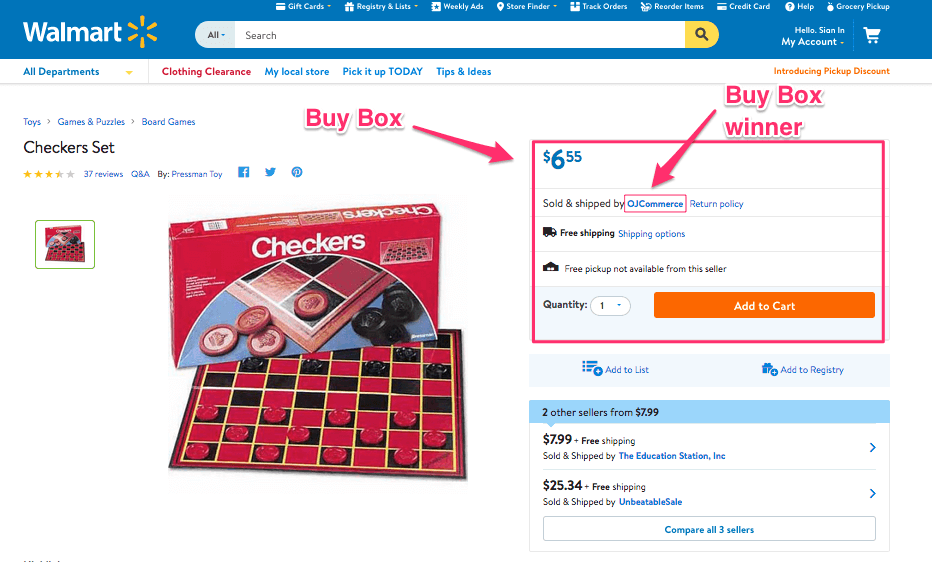
As I mentioned earlier, multiple sellers can sell the same item and much like with Amazon, all sellers are part and parcel of a mutual product listing for a specific product UPC. If a buyer decides to purchase a certain product they click on the ‘add to cart’ button and that buyer will automatically but the product from whomever has won the buybox at that given time. Walmart also shows the other sellers associated with a specific product and this gives the shopper the ability to make their own informed decision based on price, ratings etc. This list looks as follows:
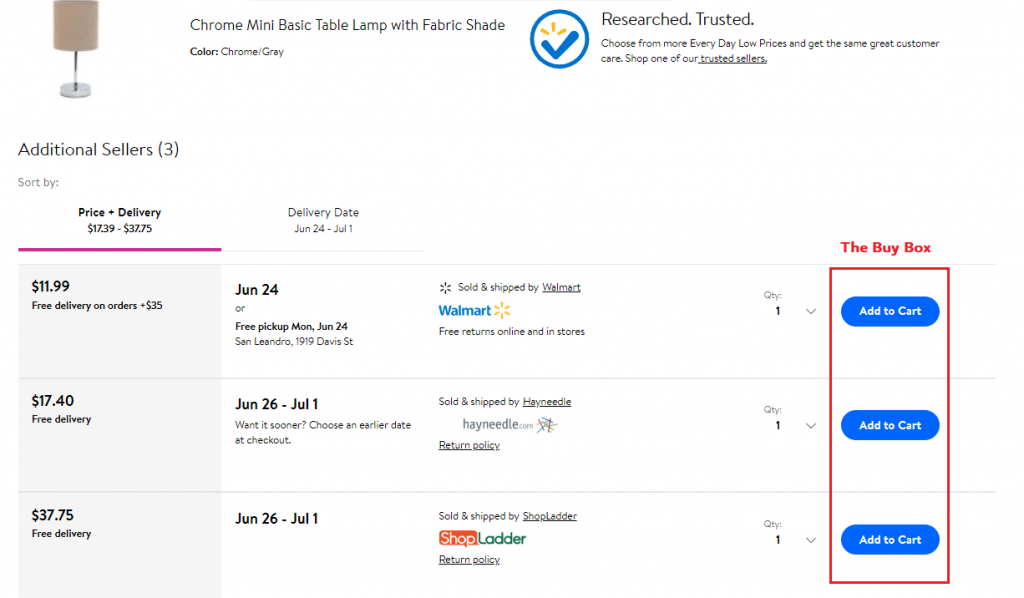
I am text block. Click edit button to change this text. Lorem ipsum dolor sit amet, consectetur adipiscing elit. Ut elit tellus, luctus nec ullamcorper mattis, pulvinar dapibus leo.
Here are three ways to capture as many sales as possible and potentially win the buy box:
- Keep your prices competitive in comparison with your competition.
- Incentivize shopper with swift/free shipping.
- See tip 3 ie make sure you get as much positive feedback as possible.
4. Be on top of pricing – Yes, shoppers want quality but if 3 sellers are selling the same item and one is offering it at a significantly cheaper price – why would a savvy modern shopper buy from you and not the cheaper listing? They won’t! In this example 3 sellers are selling the same lamp, one seller has it listed at $11.99 and the other 2 have it listed at $17.40 – answer honestly who you would buy from if you were in the buyer’s shoes. By being on top of your direct competitor’s pricing you can generate more sales on your Walmart store.
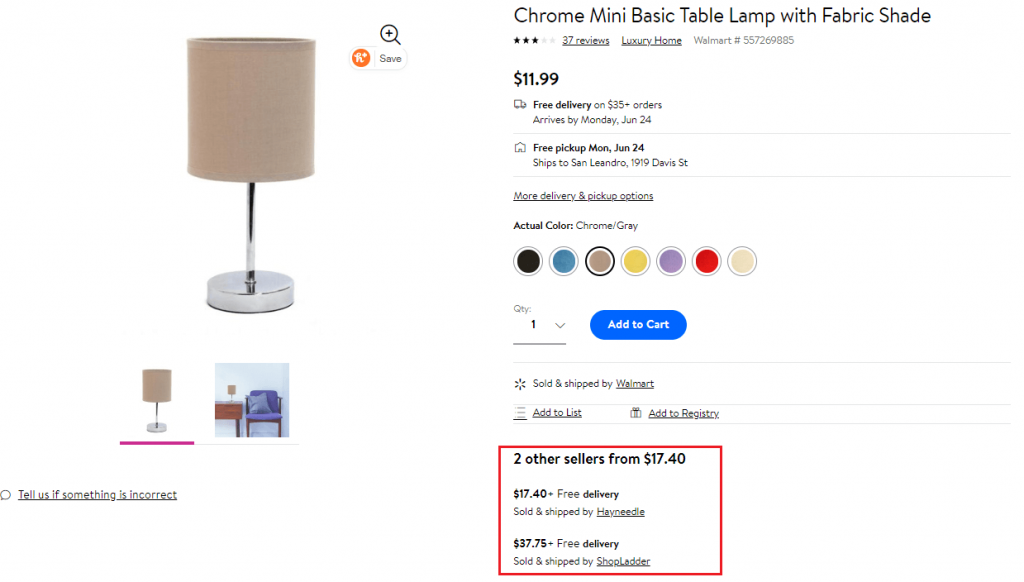
5. Offer a variety of shipping options – As I am sure you know and as I mentioned above, shipping is a huge deal in eCommerce. All the major players are trying to undercut each other in this respect – Amazon with Prime, eBay with its new Managed Delivery service and Walmart with its free 2-day shipping with no membership fees. Marketplaces understand how the ‘instant culture’ has affected consumer expectations and as a Walmart seller you have to appreciate this as well and be able to offer a variety of shipping options to meet every type of buyer’s needs. The two options on Walmart are:
- Standard shipping which takes between 2 and 5 days.
- Express shipping which takes between 1 and 2 business days.
The first thing I would recommend is offering free shipping and including the cost in the price of the product itself so that the customer perception is that they are getting something free. And second of all, consider upgrading repeat customers and or buyers who place large orders to express shipping even if they don’t expressly request this. This is sure to leave a positive impression, generate positive feedback and create a positive ‘butterfly effect’ for your business.
Over to You
It was my pleasure to introduce everything there is to know about Walmart’s marketplace. It is important to be acquainted with the different options available to you as an eCommerce business owner, especially if you are looking for opportunities for growth. As you have seen, selling on Walmart is not for everybody. For those of you who cannot yet pass Walmart’s stringent prerequisites, instead of being discouraged, take this as a challenge and try to improve your performance on eBay and/or Amazon and try applying again in a few months. There is nothing like hearing ‘no’ from someone to motivate you even more. Fun fact: Jack Ma, the founder of the Chinese marketplace known as Alibaba which is currently worth $463 Billion was rejected from Harvard 10 times and ultimately it was those rejections that helped motivate him to succeed in business! Have you applied to gain seller status on Walmart – I’d love to hear your personal story in the comments below.



